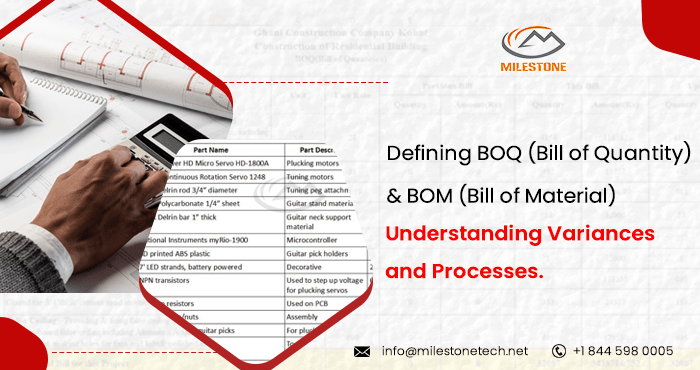Defining BOQ (Bill of Quantity) and BOM (Bill of Material): Understanding Variances and Processes

In the realm of construction services, precise planning and execution are paramount. Two essential tools that play a crucial role in this process are the Bill of Quantity (BOQ) and the Bill of Material (BOM). These documents serve as the backbone for project management, helping streamline processes, control costs, and ensure project success. In this article, we will delve into the definitions, variances, and processes associated with BOQ and BOM.
Bill of Quantity (BOQ):
The Bill of Quantity, commonly known as BOQ, is a comprehensive document that outlines the itemized list of materials, labor, and services required for a construction project. It serves as a roadmap for the project, detailing the quantity and quality of each component. Engineers and project managers rely on BOQs to estimate costs accurately, allocate resources efficiently, and ensure that the project is executed according to specifications.
Key Components of a BOQ:
- Item Description: Each item in the BOQ is precisely described, including specifications, standards, and any other relevant details.
- Unit of Measurement: The quantity of each item is specified along with the unit of measurement, be it meters, kilograms, or any other applicable unit.
- Rates and Prices: The BOQ includes the rates or prices associated with each item, allowing for accurate cost estimation and budgeting.
- Labor and Overhead Costs: In addition to materials, the BOQ may include labor and overhead costs, providing a holistic view of the project’s financial requirements.
Bill of Material (BOM):
On the other hand, the Bill of Material, or BOM, is a document that specifies the raw materials, components, and sub-assemblies needed to manufacture a product. While BOQ is more focused on construction projects, BOM is widely used in manufacturing and production processes.
Key Components of a BOM:
- Assembly Hierarchy: BOMs often have a hierarchical structure, outlining how different components come together to create a final product.
- Material Specifications: Each material or component in the BOM is detailed with specifications, ensuring consistency and quality in the manufacturing process.
- Quantities: Similar to BOQ, the BOM includes quantities for each item, helping in material planning and inventory management.
Understanding Variances:
Despite their differences, BOQ and BOM share a common challenge: variances. Variances occur when there is a difference between the planned or estimated quantities and the actual quantities used or consumed. These discrepancies can lead to cost overruns, delays, and quality issues.
Managing Variances in BOQ:
- Regular Monitoring: Continuous monitoring of construction processes helps identify discrepancies early on, allowing for timely adjustments.
- Documentation and Reporting: Accurate record-keeping and reporting facilitate a transparent overview of the project’s progress, making it easier to address variances.
Managing Variances in BOM:
- Quality Control: Implementing stringent quality control measures ensures that the materials and components meet the specified standards, reducing the likelihood of variances.
- Supply Chain Management: Efficient supply chain management helps in ensuring a steady and reliable flow of materials, minimizing disruptions and variances.
Processes for Effective BOQ and BOM Management:
- Collaboration: Effective communication and collaboration between project stakeholders, including engineers, architects, and suppliers, are crucial for accurate BOQ and BOM development.
- Technology Integration: Leveraging advanced AI tools and technology for creating, managing, and analyzing BOQs and BOMs enhances accuracy and efficiency.
Conclusion
In the dynamic world of construction, mastering the art of managing BOQ and BOM is indispensable. Understanding the nuances of these documents, addressing variances, and implementing efficient processes contribute to the success of projects, ensuring they are completed on time, within budget, and to the highest quality standards. As technology continues to evolve, embracing new AI tools becomes essential for staying ahead in the ever-changing landscape of BIM services.
Follow Milestone PLM Solutions for AEC Industry Updates, CAD Tips and Global Construction News.
Milestone PLM Solutions with its exclusive delivery center in India is a global CAD, BIM outsourcing partner serving the needs of the AEC industry since 2004. MILESTONE focuses on the unique needs of clients and believe in tackling real-life problems with efficiency, smooth and ease.
The MILESTONE team can assist you with DD Set, CD Set, BIM Modeling, Rendering, walk through and more. We support multiple BIM software including AUTOCAD REVIT, Architecture cad, Vector works etc. Our approach is to provide a dedicated team for each customer over ongoing project and deliver the quality output consistently.
With our state of art technology and large talent pool of Engineers & Architects, we are developing best in class solutions for our customers across the globe. We align with your culture and values to form unbreakable partnerships and are primed for success with over 100 employees and 150 customers in the US, Europe, India, and Asia.
You can email us at info@milestonetech.net and can log in to our website www. milestonetech.net to know more about our services and our work portfolio or contact us on +1-844-598-0005
